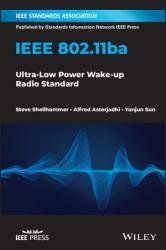 Название: IEEE 802.11ba: Ultra-Low Power Wake-up Radio Standard
Название: IEEE 802.11ba: Ultra-Low Power Wake-up Radio StandardАвтор: Steve Shellhammer, Alfred Asterjadhi, Yanjun Sun
Издательство: Wiley-IEEE Press
Год: 2023
Страниц: 187
Язык: английский
Формат: pdf (true), epub
Размер: 10.2 MB
IEEE 802.11ba Discover the latest developments in IEEE 802.11ba and Wake-up Radios.
In IEEE 802.11ba: Ultra-Low Power Wake-up Radio Standard , expert engineers Drs. Steve Shellhammer, Alfred Asterjadhi, and Yanjun Sun deliver a detailed discussion of the IEEE 802.11ba standard. The book begins by explaining the concept of a wake-up radio (WUR) and how it fits into the overall 802.11 standard, as well as how a WUR saves power and extends battery life.
The authors go on to describe the medium access control (MAC) layer in detail and then talk about the various protocols used to negotiate WUR operation, its uses for different functionalities (like wake up of the main radio, discovery, synchronization, and security). The book offers a detailed description of the physical (PHY) layer packet construction and the rationale for the design, as well as the various design aspects of the medium access control layer. It also includes:
A thorough introduction to the motivations driving the development of the WUR in 802.11
Practical overviews of IEEE 802.11, including the basic concepts of 802.11 (the PHY and MAC) and background material on current low power modes
Comprehensive discussions of the physical layer and PHY layer performance, including the generic receiver, the PPDU, Transmit Diversity, and the FDMA mode
In-depth examinations of the medium access layer and its frame designs
There are a number of methods to reduce power consumption in 802.11 devices. Most of them focus on allowing the device to enter a power save (PS) mode where some of the electronic circuits are not needed at the moment and hence lead to the power saving. However, often the 802.11 device needs to exit PS mode periodically to allow it to transmit and/or receive data packets. Therefore, there are limits to how much power savings can be obtained using these power savings techniques. So it became apparent that there was a need for a new amendment to the 802.11 standard to focus specifically on power savings and to use a more aggressive power savings technique to enable more significant power savings in 802.11 devices. This led to the development of the IEEE 802.11ba amendment of the 802.11 standard.
The IEEE 802.11ba, which was published in 2021, is a standard for a wake‐up radio (WUR). A WUR is a low‐power wireless technology that enables the development of ultra‐low‐power devices. The term “radio” is used here as a synonym for “wireless.” A WUR is a wireless technology that supports implementation of an ultra‐low‐power wake‐up receiver, which has limited wireless functionality but can be operated at very low‐power consumption levels. An 802.11 device that includes this wake‐up receiver can allow its main transmitter and receiver to be placed into a deep sleep mode, while the wake‐up receiver can be used to receive messages from an 802.11 access point (AP) when information is to be sent to or received from this 802.11 device. When the WUR receives a wake‐up message, then the main wireless technology, or main radio (MR), in the devices can be brought out of its deep sleep mode and exchange messages with the AP. This MR can be any of the standard 802.11 PHY layers, including 802.11n, 802.11ac, 802.11ax, and so forth.
One can think of this as a hierarchy of wireless systems where the MR is used to transfer data, often at a high data rate (HDR), and the WUR is used to maintain a connection between nodes in the wireless network and wake up the MR when it is time to transfer data. This hierarchy of wireless systems provides both low‐power consumption and the ability to transfer data, often at HDRs, when needed.
The WUR is particularly good at addressing one of the most challenging power consumption problems, which is when the device needs to support low‐latency data traffic while still maintaining low‐power consumption. We can illustrate this problem with an example. Say the 802.11 device needs to control an actuator in a home automation use case. Let us say the response time for the actuator needs to be short since the user wants to visually see or hear the response.
Perfect for professional wireless engineers, IEEE 802.11ba: Ultra-Low Power Wake-up Radio Standard will also earn a place in the libraries of academics and students researching and studying in fields involving wireless communications.
Скачать IEEE 802.11ba: Ultra-Low Power Wake-up Radio Standard